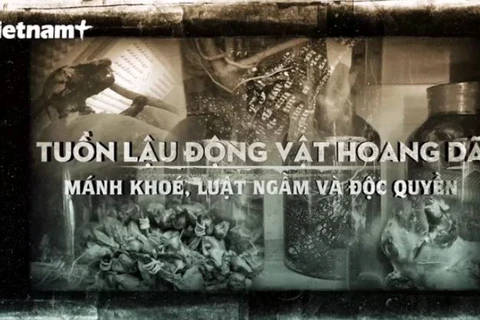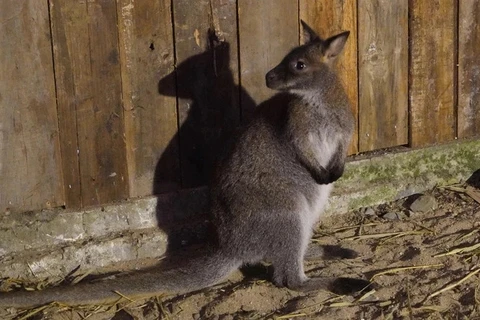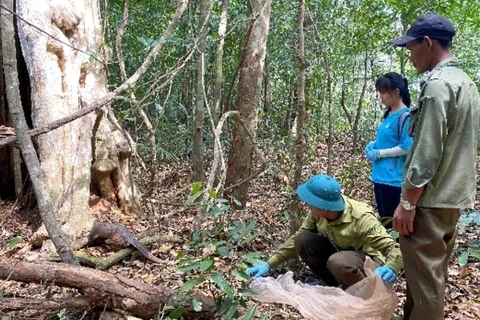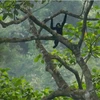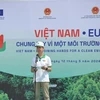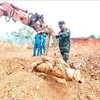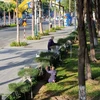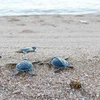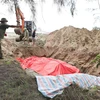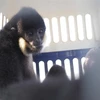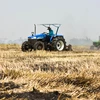Hanoi (VNA) – The United Nations World Wildlife Day (WWD) is observed on March 3 every year to celebrate wild animals and plants and highlight their contributions to human lives and health.
This year, the WWD is themed “Connecting People and Planet: Exploring Digital Innovation in Wildlife Conservation”.
According to the Ministry of Environment and Natural Resources (MoNRE), Vietnam is ranked 16th among the Earth's most biodiverse countries and is one of the ten richest centres of biodiversity in the world with many different types of ecosystems and genetic sources.
With a wide range of latitudes, Vietnam's climate varies from humid tropical conditions in the southern lowlands to temperate conditions in the northern highlands. Consequently, the country enjoys a diversity of natural environments and a high level of biodiversity in its forests, waterways, and marine areas, according to a report by the World Wide Fund For Nature (WWF).
The country has a wealth of fauna varieties: 276 species of mammals, 828 species of birds, 180 species of reptiles, 80 species of amphibians, 472 species of freshwater fish, and many thousands of invertebrate species have been identified. It is home to an estimated 12,000 species of plants. About 33% of the flora of northern Vietnam are endemic and, nationally, the percentage of endemism could be as high as 50%.
These groups show a high degree of local distinctiveness, with many endemic species of great scientific and economic significance.
Of the 34 globally threatened birds identified as occurring in Vietnam, 10 are restricted-range endemic forest species. Sixty fish species and four primate species are also endemic to Vietnam.
However, the diversity in Vietnam is in danger because of unsustainable and poorly managed exploitation, an increase in population and rapid urbanisation.
The reasons that lead to biodiversity decline are rapid population growth, pollution, deforestation, the over-exploitation of marine resources and widely applied new species without careful examination. That has led to 28% of mammals, 10% of birds, 21% of reptiles and amphibians facing risk of extinction.
The results of the largest systematic camera trap survey ever conducted in Vietnam between 2019 and 2023 with support from the United States Agency for International Development (USAID), showed that populations of several key wildlife species have either disappeared or are in such low numbers as to be unviable as a result of widespread indiscriminate snaring.
During the survey carried out by USAID’s Biodiversity Conservation Activity, 1,176 camera trap stations were set up in 21 protected areas (PAs) across eight provinces, capturing more than 120,000 independent wildlife detections in millions of images during 2019-2023.
Notable was the absence of large carnivores and herbivores, such as tigers, clouded leopards, Asiatic wild dogs, and the elusive saola – one of the few large mammals to be discovered in the world in the last 50 years. Asian elephants were detected in just two sites, and wild cattle species such as gaur only detected in one out of 21 sites surveyed. The most prevalent species recorded were those most resilient to hunting pressure, such as macaques, ferret badgers and wild pigs.
Although the survey revealed that wildlife has severely declined in all 21 PAs, there are still relatively high levels of species richness and endemism, with nine Annamite-endemic and 21 non-endemic but highly threatened species recorded. Rare species, such as the large-antlered muntjac and sun bear were also detected, providing some of the few records of these species in Vietnam in the past 20 years.
Nick Cox, Chief of Party, USAID Biodiversity Conservation, implemented by WWF, stated: “For the first time we have the data to confirm Việt Nam’s wildlife populations are in dire straits. At the same time there are signs that investments by the Vietnamese Government, and by local and international NGOs, have had a positive impact. Now is the time to start a national conservation breeding programme to rewild the country’s protected areas, while protection efforts are sustained and increased, especially to reduce snaring.”
According to MoNRE, Vietnam has proactively participated and implemented many commitments related to wildlife protection.
Recently, the ministry has proposed the Prime Minister on promulgating a programme to conserve endangered, precious and rare wild animals prioritised for protection until 2030, with a vision to 2050. Accordingly, Vietnam aims to ensure that no more species prioritised for conservation become extinct. All of the species prioritised for protection will be managed and monitored in nature reserves, high biodiversity areas and biodiversity conservation facilities.
The ministry proposed to investigate and assess the current status of populations and habitats of species prioritised for protection nationwide. It also asked for periodically updating information and data and publishing the list of species prioritised for safeguarding. In particular, priority should be given to restoring habitats of species that are threatened with extinction and migratory species prioritised for protection including elephants, saola, Truong Son muntjac, Truong Son striped rabbit, central Vietnam turtle, and box turtle.
Meanwhile, USAID has sponsored a project to protect endangered wildlife species in Vietnam with a funding of 10.5 million USD for over 5 years starting from 2021. It supports enhancing leadership in combating illegal wildlife trade by improving and harmonising the legal system related to wildlife protection, strengthening law enforcement and prosecution over wildlife crimes, and reducing illegal demand and consumption of wildlife./.



